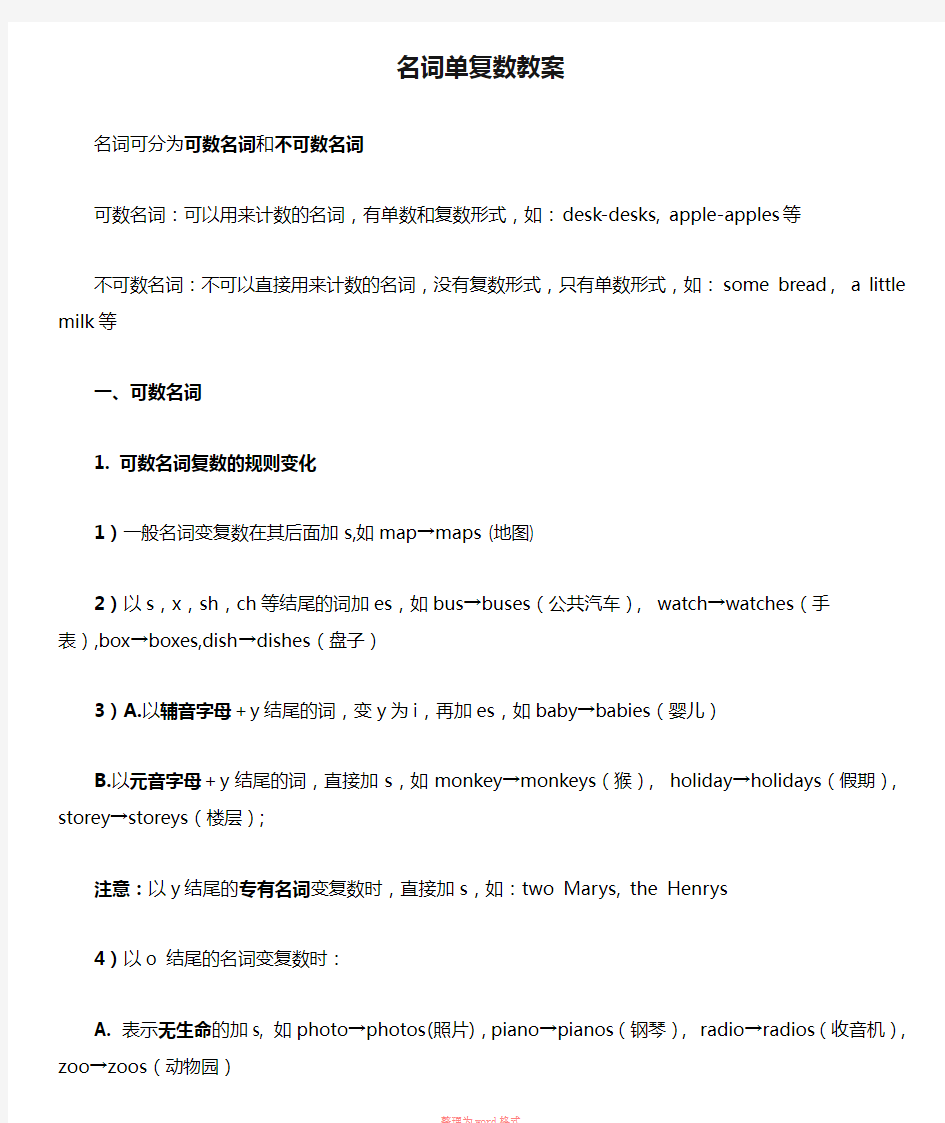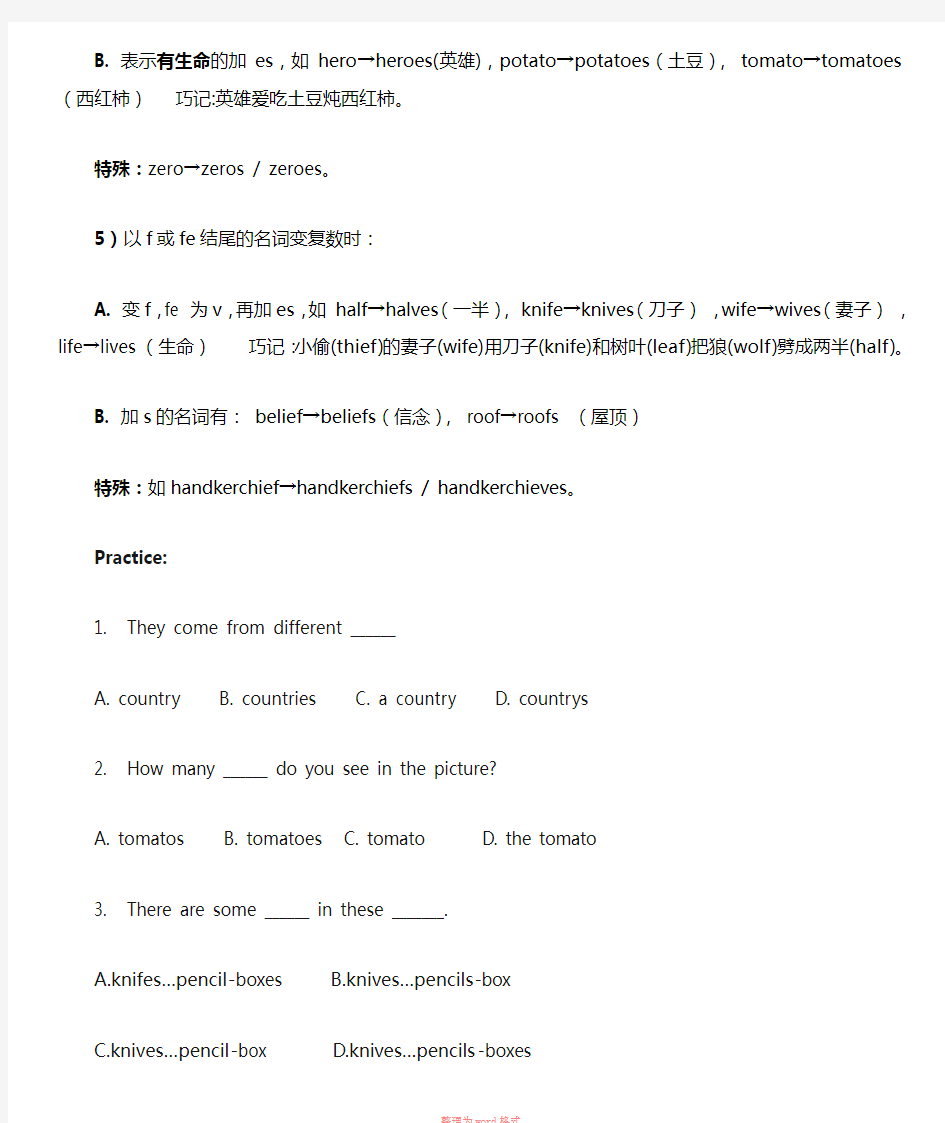

名词单复数教案
名词可分为可数名词和不可数名词
可数名词:可以用来计数的名词,有单数和复数形式,如:desk-desks, apple-apples等
不可数名词:不可以直接用来计数的名词,没有复数形式,只有单数形式,如:some bread, a little milk等
一、可数名词
1. 可数名词复数的规则变化
1)一般名词变复数在其后面加s,如map→maps (地图)
2)以s,x,sh,ch等结尾的词加es,如bus→buses(公共汽车),watch→watches(手
表),box→boxes,dish→dishes(盘子)
3)A.以辅音字母+y结尾的词,变y为i,再加es,如baby→babies(婴儿)
B.以元音字母+y结尾的词,直接加s,如monkey→monkeys(猴),holiday→holidays(假期),storey→storeys(楼层);
注意:以y结尾的专有名词变复数时,直接加s,如:two Marys, the Henrys
4)以o 结尾的名词变复数时:
A. 表示无生命的加s, 如photo→photos(照片),piano→pianos(钢琴), r adio→radios(收音机),
zoo→zoos(动物园)
B. 表示有生命的加es,如hero→heroes(英雄),potato→potatoes(土豆),tomato→tomatoes(西
红柿)巧记:英雄爱吃土豆炖西红柿。
特殊:zero→zeros / zeroes。
5)以f或fe结尾的名词变复数时:
A. 变f,fe 为v,再加es,如half→halves(一半),knife→knives(刀子),wife→wives(妻
子),life→lives (生命)巧记:小偷(thief)的妻子(wife)用刀子(knife)和树叶(leaf)把狼(wolf)劈成两半(half)。
B. 加s的名词有:belief→beliefs(信念),roof→roofs (屋顶)
特殊:如handkerchief→handkerchiefs / handkerchieves。
Practice:
1. They come from different ______
A. country
B. countries
C. a country
D. countrys
2. How many ______ do you see in the picture?
A. tomatos
B. tomatoes
C. tomato
D. the tomato
3. There are some ______ in these _______.
A.knifes…pencil-boxes
B.knives…pencils-box
C.knives…pencil-box
D.knives…pencils-boxes
4. _______ are good for our health.
A. Tomatos
B. Tomatoes
C. Tomato
5. I like to eat cake with ______.
A. cherries
B. cherry
C.cherrys
6. ______ and ______ are not friends.
A. Foxs…wolfs
B. Foxes…wolfs
C. Foxes…wolves
2.可数名词复数的不规则变化
1)child---children foot---feet tooth---teeth
mouse---mice man---men woman---women
goose---geese(鹅)
注意:1)由一个词加 man 或 woman构成的合成词,其复数形式也是 -men 和-women,如an Englishman,two Englishmen,因为German不是合成词,故复数形式为Germans;由man 或 woman构成的复合名词变复数时,两个名词需要同时变为复数形式,如 woman teacher-wowen teachers, man doctor-men doctors 2)单复同形,如deer,sheep,fish,Chinese,Japanese,jin,yuan,mu等。除人民币的元、角、分外,美元、英镑等都有复数形式。如:two dollars, two pounds。
3)表示“某国人”的复数变化规则
巧记:中日瑞士都不变,英法变,其他后面加s.
Chinese→Chinese,Japanese→Japanese,Swiss→Swiss;Englishman→Englishmen,Frenchman→Frenchmen;German→Germans,Canadian→Canadians
4)“数词+名词”作定语时,这个名词保留单数形式, 要用连字符连接,例如:
two-dozen eggs 两打鸡蛋 a ten-mile walk 十英里路
two-hundred trees 两百棵树 a five-year plan. 一个五年计划
Practice:
1. They are______.
A . woman teachers B. women teachers
C. women teacher
D. woman teacher
2. Would you like _______ ,please?
A. two glass of water
B. two glasses of water
C. two glass of waters
D. two glasses of waters
3. Most of ______ live in _______.
A. Germans, German
B. German, Germen
C. Germen, Germany
D. Germans, Germany
4. These are the ______ of our national ______.
A. photos … heroes
B. photoes … heroes
C. photos … heros
5. The ______ are running on the ______.
A. deer … grasses
B. deers … grass
C. deer … grass
6. I was so hungry and I ate two ______.
A. bowls of noodle
B. bowls of noodles
C. bowl of noodles
要注意的问题:
1)以s结尾,仍为单数的名词,如:
a. maths,politics,physics等学科名词,一般是不可数名词,为单数。
b. news 为不可数名词。
c. the United States,the United Nations 应视为单数。
2)集体名词,以单数形式出现,但实为复数。例如:
people,police,cattle 等本身就是复数,后面谓语动词用复数,不能说 a people,a police,a cattle,但可以说a person,a policeman,a head of cattle
3)只有复数形式的名词 trousers裤子,pants裤子,shorts短裤 glasses眼镜,compasses圆规,scales 天平,pliers钳子,clips剪子。traffic lights交通灯(一般有三盏,这样理解)sports(运动),做主语时,谓语动词用复数
4)the+ 姓氏复数表示一家人,如: The Greens like playing tennis.
5)另外还有一些名词,其复数形式有时可表示特别意思,如:goods货物,waters水域,fishes(各种)鱼。6)名词所有格
1)一般情况下,单数名词的所有格是在词尾直接加"'s",如the boy's bag 男孩的书包;复数名词词尾没有s,也要加"'s",如men's room 男厕所;若名词已有复数词尾-s ,只加" ' ",如:the workers' desks 工人的桌子。
2)表示两人或多人共同拥有某物时,只需在最后一个名词词尾加’s;表示两人或多人分别拥有时,各个名词词尾都需加’s
John's and Mary's rooms(两间)John and Mary's room(一间)
3) 表示时间,距离,国家,团体等无生命的东西的名词,也可+’s ,
如,nine hour’s walk yesterday’s work
4) 有些名词所有格表示诊所,家,店铺
如,at the doctor’s at Mary’s at the barber’s
5) 无生命的名词所有格一般用of构成
如,a map of China the name of the city
Practice:
1. ______ like ______ by air.
A. Greens, travelling
B. The Green, traveling
C. The Greens, travel
D. The Greens, traveling
2. I wonder why ______ are interested in action films(武打片).
A. the people
B. people
C. peoples
D. the peoples
3. There is no ______ in the plate.
A. apples
B. oranges
C. rice
D. eggs
二、不可数名词
1)常见的不可数名词:a dvice, hair, homework, work,information, knowledge, money, news, progress,health,time,baggage(行李), change(零钱), furniture(家具)
2)不可数名词如何表示数量:通常用"数词+单位词+of"来表示。如: a piece of paper, three pieces of paper等。
a piece of bread(paper(纸), cloth(布), news(新闻), advice(意见), information(信息), ,
meat(肉) )
a cake of soap 一块肥皂 a tube of tooth paste 一条牙膏 a bottle of ink 一瓶墨水
当单位词可数,且前面的数词大于一时,单位词需要用复数形式,
如two bottles of water 两瓶水 two pieces of paper 两张纸
3)有些物质名词单复数形式表示不同含义, 如,fruit 水果---- fruits各种各样的水果,glass 玻璃---- glasses眼镜,玻璃杯,paper 纸----papers 报纸;论文;试卷(a daily paper 日报),coffee 咖啡----four coffees四杯咖啡
可数名词和不可数名词的主谓一致问题:
1)可数名词作主语时,谓语动词的单复数与主语的单复数保持一致。如:
These pictures are very beautiful. 这些画很美。
2)不可数名词作主语时,谓语动词要用单数形式,但是不可数名词前有复数"单位词"时,谓语动词要用复数形式。如:
Two cups of tea are on the table. 桌上有两杯茶。
真题重现:
友情提示:本资料代表个人观点,如有帮助请下载,谢谢您的浏览!